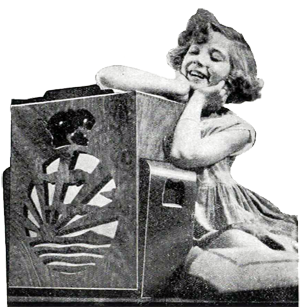Articles
Pye tube radios: short review
 During the late 1920's the radio manufacturer, W.G PYE & Co, of Cambridge, England were certainly not short with commercial modesty when it incorporated it's famous "rising sun" motif as the fret work speaker design for their range of wooden cased walnut veneered receivers. The sets produced in this way, examplified the very "Englishness" of contemporary Art Deco, and continued through to the late 1940's with it's final, and somewhat maligned model M78F (see below).
During the late 1920's the radio manufacturer, W.G PYE & Co, of Cambridge, England were certainly not short with commercial modesty when it incorporated it's famous "rising sun" motif as the fret work speaker design for their range of wooden cased walnut veneered receivers. The sets produced in this way, examplified the very "Englishness" of contemporary Art Deco, and continued through to the late 1940's with it's final, and somewhat maligned model M78F (see below).
Like all good legends, the rising sun was allegedly discovered on a silver cigarette case by the company's marketing director, and was immediately adopted as the company's corporate image. The design was certainly very eye catching, and any browsing shopper in the halcyon days of the 1930's could hardly fail to miss it amongst the mass of receivers on a radio dealer's shelf.
The very first example was the battery portable model 25 of 1927. This was quickly followed by other distinct models (listed below) before bowing out in 1948 with the notorious model M78F.
Throughout the company's history, the "rising sun" motif had always been a cloud speckled sun over a wavy sea. After World War II the company overhauled the logo and removed the cloud pattern. Pye had obviously forgotten that the recent enemy of Japan had also used a similar design as their national flag, and the resulting howls of protest, forced the company to hastily remove the set from general circulation and consign the entire production run to a factory pyre.
How Pye did not notice the blatant similarity will never be answered, but because of this act, the set is comparatively rare in general circulation, but it is evident there is not as few as might be expected, as many are in collector's hands. This would suggest that perhaps some escaped the factory fire via the perimeter fence, but like all great conspiracies, the point is a moot one, and highly conjectural. Following this act of inepitude, the logo had disappeared forever from the front of Pye radios, and the company image had been irretrievably tainted.
Some of these treasures are illustrated below, but the full production list (currently acknowledged) were:
- 1927 - Models 25 and 25B
- 1928 - Model 275
- 1929 - Model 25C (all listed sets to 1929 virtually identical)
- 1930 - Type AC4D (Also known as the Pye "Twin Triple Transportable") - (illustrated)
- 1930 - Type B4D (Also known as the Pye "Twin Triple Portable")
- 1931 - Model MM and Model Q (illustrated)
- 1932 - Models G, (illustrated) K, (illustrated) and S
- 1933 - Models E, O, and P (illustrated)
- 1937 - Model "Baby Q"
- 1948 - Model M78F
Prices for these sets vary considerably, but expect to pay from £90 for the mid 30's sets, through to at least £300 for the rare M78F. These prices are based on sets in very good condition. For the "Twin Triple" sets the price is around £150 to £200 per set, but the same criteria applies. For sets in poor or damaged condition expect to pay half, or a quarter of the best condition sets.

From: www.vintageradiotimes.com
Add comment:
| Name: | ||
| code protection:* | ||
| email:* | ||

 Main
Main